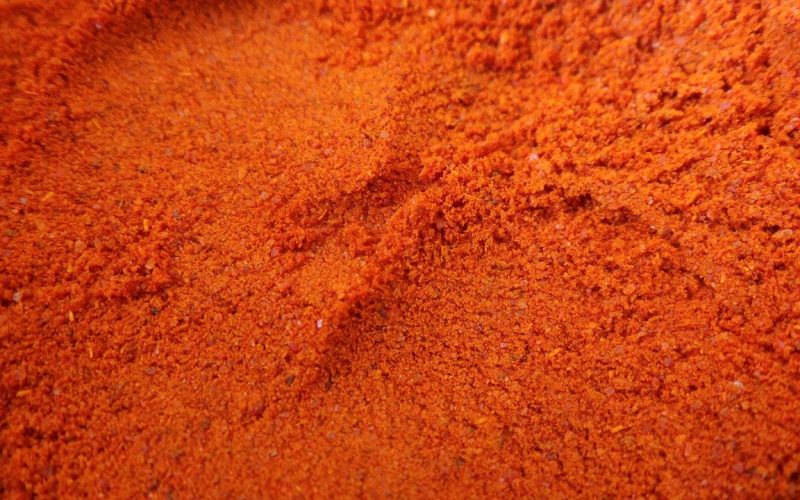Ancho chili powder is the preferred chili powder for real Mexican cooking. It is a moderately hot powder made from entirely dried ancho chilis.
One of the most popular chili powders in Mexican cookery is this one. Poblano chilis, also known as ancho chilis, are dried and processed to create powder with moderate flavor and a dark hue.
Pork and beef go well with the ancho chili’s taste, which has a somewhat raisin-like undertone. The flavor of ancho powder is earthy with a hint of spice.
The Poblanos from which it originates have a fruity taste and a mild heat. Dark crimson to nearly black poblanos have a heart-shaped form.
Ancho chile powder is a well-liked Mexican spice, mostly used for flavoring. It is dark, rich, and smoky.
But if a dish you’ve wanted to try for a while asks for it and you can’t locate any at home or readily find one, you may make a small concession and use one of the substitutes for ancho chili powder instead.
What is Ancho Powder?
Ancho Powder is a spice made from grinding dried Poblanos or Ancho chili peppers, as was previously explained.
A dark, smoky chili is ancho. It is a fundamental element in most Mexican cuisine and has a sweet, raisin-like flavor.
Ancho chili powder is a well-liked spice made only from dried and crushed ancho chilis. It has mild heat with fruity overtones.
It is frequently used in mole sauce and spice rubs and is occasionally written “ancho chili powder.” Ancho chili powder contains just one chili: powdered dried poblanos.
This contrasts with chili powder, a combination of ground spices, including ground chilis, garlic powder, onion powder, paprika, and/or cayenne pepper.
Here are some substitutes for ancho chili powder in case you need to replace that moderately spicy ingredient made from whole dried poblano peppers known as ancho chilis.
Substitutes for Ancho Chili Powder
1. Guajillo Chili Powder
Guajillo chili powder can be used as a substitute for ancho chili powder. It is just a little hotter than the peppers used to manufacture ancho chili powder, with a medium heat rating of 3,750 Scoville units.
Guajillo chili powder is derived from the second-most popular chili in Mexico, after ancho chilis. It has an acidic, delightfully spicy flavor with overtones of berry and pine.
The Spanish term “guajillo” refers to the pepper’s resemblance to a “small gourd” in form. Although guajillo powder may be used in nearly any recipe for chilis.
It is most frequently seen in Mexican and Southwestern dishes, where it is used to flavor anything from stews and braises to mole sauces.
Be advised: It has a modest heat but a distinctive flavor. You may use guajillo for ancho chili powder in recipes one-to-one, but you should taste as you go and remember that a little goes a long way to prevent overdosing.
2. Chipotle Powder
Although hotter than ancho chili peppers, the chipotle powder is entirely formed of dried and crushed chipotle chilis and has a mild heat with fruity overtones.
As one of the simplest substitutes for ancho chili powder, it is also the chili powder most frequently found in large grocery shops.
If you want to use chipotle chili powder instead of the ancho chili powder because it is hotter, you might want to taste test it beforehand.
Switch to Chipotle if you want to season your meat or shellfish with ancho chili powder but don’t have any. These are fantastic substitutes for traditional chili powder.
Additionally, chipotle chile powder enhances the flavor of any filling in tacos, burritos, enchiladas, quesadillas, and other foods.
3. Paprika
To use substitutes for ancho chili powder, like paprika, is a fantastic option and a good heat match.
Choose mild paprika if available; it may be a little sweeter than ancho chile powder, but it will do in a pinch.
Paprika originates from the genus Capsicum annuum, which also contains red peppers, bell peppers, and chili peppers.
Grades describe the heat level and flavor characteristics of various spice mixes.
Smoked paprika hints at burnt flavor, but sweet paprika, typically called “paprika,” is milder than hot.
Paprika was first grown in what is now central Mexico and was carried back to Spain by Spanish explorers in the sixteenth century.
From then, it gained popularity in various regions of Europe, Asia, and Africa. Use a 1:1 substitution in dishes; add a little cayenne pepper if you want it to be spicier.
4. Pasilla Chili Powder
The dried chilaca peppers used to make pasilla chili powder have earthy undertones that go well with mole recipes.
Because chili powder and ancho chili powder have similar characteristics, including a mild heat level (although anchos can be a bit stronger), chili powder can be used as a substitute for ancho chili powder.
In light of this, distinguish between the two while shopping because some supermarket stores frequently identify ancho chili powder as pasilla powder.
The hue of ground pasilla chile powder varies from dark purple to black. It has a dark, rich, and nearly chocolatey flavor with undertones of prunes and raisins.
Use this spice sparingly if your meal needs a little chili taste. It is more of a star ingredient than a background accent.
It enhances compound kinds of butter, which may be used on anything from bread to vegetables, in addition to complimenting mole sauces and recipes that use beans. Replace ancho powder in recipes with pasilla powder, 1:1.
5. Mulato Pepper Powder
Mulato Chili is a mild to moderate chili with a taste comparable to ancho chili peppers. It is most frequently used in soups, stews, and moles, much like ordinary Mexican chili powder.
Mulato peppers, however, have a deeper shade and a richer flavor when compared to ancho chili powder.
Mulato pepper powder has undertones of licorice and chocolate, so it’s frequently used to provide a tingling heat to sweeten foods and sweets.
If you want to make baked goods or ice cream with chili tastes, you may use Mulato pepper powders as substitutes for ancho chili powder.
6. New Mexico Chili Powder
Dried New Mexico chilies are ground to create New Mexico chili powder.
New Mexico chilis are six inches long and two inches broad compared to ancho peppers.
Additionally, it smells like dried fruits and herbs. These ought to work perfectly as substitutes for ancho chili powder.
Although immature (green) and fully matured (red), New Mexico chilis can be ground, and red chilis, such as dried Anaheim chili, are often used to make the powder.
Although the New Mexico chili powder may have a different flavor, it should provide ancho chiles with a well-matched heat level.
7. Cayenne Pepper
Cayenne pepper is a member of the Capsicum family of fiery chilies, typically used to season food. The tiny, slender, and long chilies make cayenne pepper chili powder.
You might need to combine cayenne chili pepper with other, sweeter varieties of chili powder to substitute ancho chili powder because it is significantly hotter than ancho chili.
Combining it with pasilla powder or New Mexico chili powder can be a good idea.
Indian, Thai, Chinese, Korean, Creole, and other cuisines frequently employ cayenne chile powder.
Use a smaller amount of cayenne pepper substitutes for ancho chili powder.
8. Red Chili Powder
Chili powder mixtures frequently include ancho chilies, which proves that red chili powder mixes may be substitutes for ancho chili powder.
This well-liked condiment includes cumin, oregano, and red chili powder.
9. Chili Powder And Ground Red Pepper
In various recipes, ancho chili powder may be replaced with ordinary chili powder and a tiny amount of ground red pepper. Because red pepper is so hot, add a little of it.
In place of one teaspoon of ancho powder, use one teaspoon of ordinary chili powder and either a 1/4 or a 1/8 teaspoon of powdered red pepper.
Even though ancho chili and chili powder can be used interchangeably, it’s crucial to understand that they are different spices.
Ancho chili is made with poblano peppers, while chili powder contains pulverized chilies, garlic, onion, and other spices.
Consequently, the tastes will be different. Additionally, it’s crucial to taste the chili powder first to determine how much ancho chile it tastes before adding it to your cuisine.
10. Arbol Chili Ground
This spicy chili powder is created by crushing dried chile de Arbol pods.
Rat’s tail chili is another name for chili de Arbol, meaning “tree chili.” It is a little but extremely strong chili pepper.
Initially, green chili de bol matures to a fiery red color. Although they are used to adorn wreaths, their culinary use includes vinegar flavoring, etc.
Ancho chili powder can be substituted in Mexican dishes, even though it is typically used in Southwestern cuisines. This spice is quite hot and has a distinctive kick.
Because it contains 15,000 to 30,000 SHU, use caution when substituting it for ancho powder. Therefore, a pinch would replace one teaspoon of ancho powder.
Like most chili peppers, it may be included in Mexican cuisines like salsa and chili. It is also a good dietary fiber source.
De Arbol also has a high vitamin A content and a moderate level of vitamin C.
Chili de Arbol should be kept in an airtight container in a pantry or cabinet.
You may freeze it to maintain the flavor’s full strength, extending its shelf life to up to a year. Normally, I’d advise using it 3 to 6 months after opening.
11. Chili Flakes
Ancho chili powder may easily be replaced with chili flakes. The finest aspect is that they are readily available in all shops worldwide.
Like ancho chili, they are likewise composed of dried peppers, but because they may be hotter, they use fewer.
Conclusion
If you’re creating Mexican cuisine, ancho chili may offer just the perfect amount of flavor and spice, but if you don’t have any, you can always substitute another spice from our list.
You could use some instead of the original ancho chili component because some flavors are even stronger.
Hopefully, this collection of ancho chili alternatives will help you discover the ideal substitutes for ancho chili powder.
They could be available at grocery shops or internet retailers.
All are simple to locate possibilities. However, the spice level may differ depending on the cultivars.
Pepper should always be used sparingly and then progressively increased to taste. Using alternatives to ancho chili powder in this way is never a bad idea.








